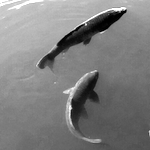Olfaction is a multiscale physico-chemical process. The small size of insects and their far-located targets make odor-based sensing and orientation a difficult task. Still, male moths have developed amazing abilities to locate females through sex pheromones, with a single molecule captured being sufficient to trigger a neuronal response. This puzzle amazed Fabre over a century ago and is still unsolved today.
The insect main olfactory organ, the antenna, can be of highly complex, multiscale architecture and the incessant antennal movement is a characteristic of foraging insects. How these features enhance the chances to locate the olfactory target is unknown. In this talk, I first survey our work on sex pheromone capture by feathery antennae of Samia cynthia. We show, using a combination of PIV flow measurements with scaled models and computational transport models, how the feathery, porous antennae are well designed for capturing molecules at the flight speed at which the searching male is flying. We also question under which circumstances the most common simpler, cylindric shape can still be quite effective. Moving actively antennae is another strategy which increases the capture of odorants, at the behavioral level. This active sensing is of importance not only for animals but also in the context of robots searching for explosives, substances of low vapor pressure and in context in which time is of essence. The antennal 3D kinematics of bumble bees tracked by video dispaly stereotype movement patterns irrespective of the physico-chemical characteristics of the odorants tested. We thus reproduced the basic movement pattern in a newly designed flow tank with mocked antennae and quantified the flow and mass transfers. The speed and frequency ranges of movement at which under- and oversampling are avoided – representing low chances of molecule capture or time lost, respectively- remains an interesting open problem in physics, both for similar biological problems and also in other technological applications.

 PDF version
PDF version
